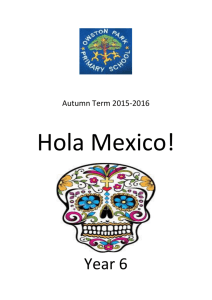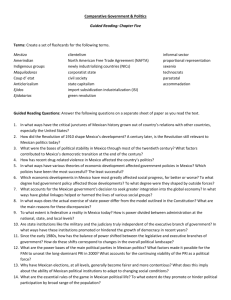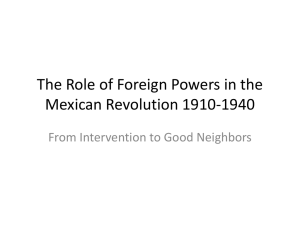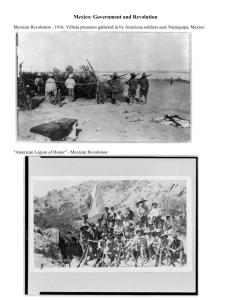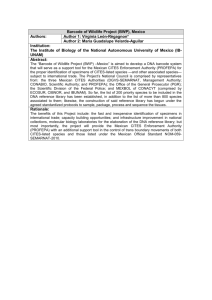The Mexican Revolution
advertisement
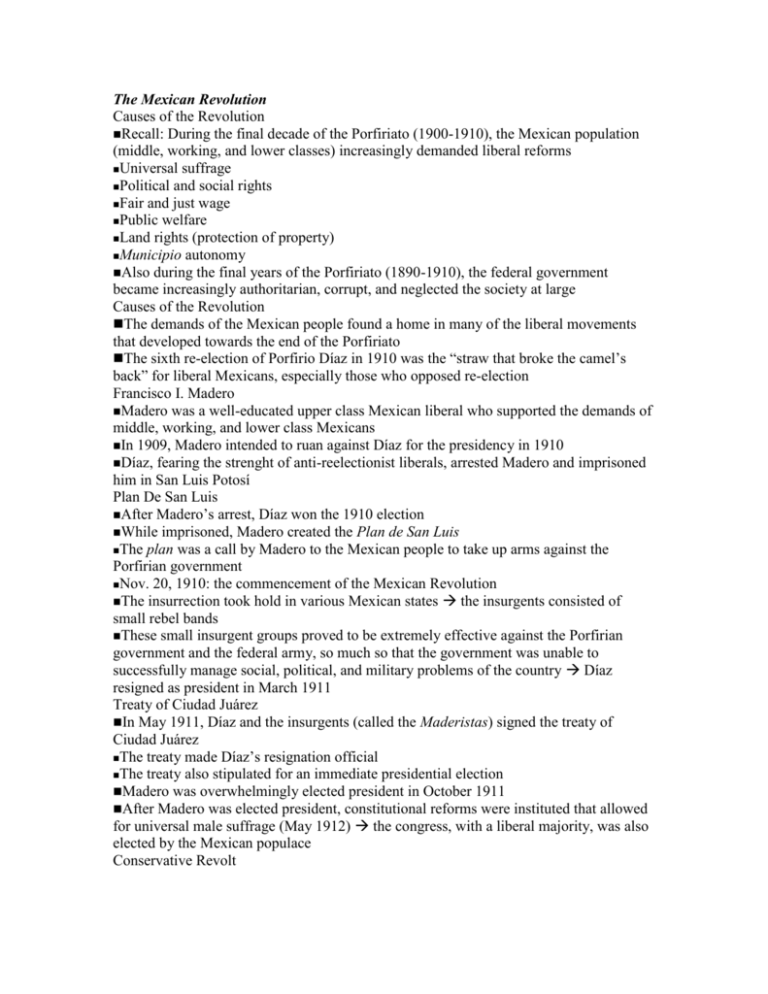
The Mexican Revolution Causes of the Revolution Recall: During the final decade of the Porfiriato (1900-1910), the Mexican population (middle, working, and lower classes) increasingly demanded liberal reforms Universal suffrage Political and social rights Fair and just wage Public welfare Land rights (protection of property) Municipio autonomy Also during the final years of the Porfiriato (1890-1910), the federal government became increasingly authoritarian, corrupt, and neglected the society at large Causes of the Revolution The demands of the Mexican people found a home in many of the liberal movements that developed towards the end of the Porfiriato The sixth re-election of Porfirio Díaz in 1910 was the “straw that broke the camel’s back” for liberal Mexicans, especially those who opposed re-election Francisco I. Madero Madero was a well-educated upper class Mexican liberal who supported the demands of middle, working, and lower class Mexicans In 1909, Madero intended to ruan against Díaz for the presidency in 1910 Díaz, fearing the strenght of anti-reelectionist liberals, arrested Madero and imprisoned him in San Luis Potosí Plan De San Luis After Madero’s arrest, Díaz won the 1910 election While imprisoned, Madero created the Plan de San Luis The plan was a call by Madero to the Mexican people to take up arms against the Porfirian government Nov. 20, 1910: the commencement of the Mexican Revolution The insurrection took hold in various Mexican states the insurgents consisted of small rebel bands These small insurgent groups proved to be extremely effective against the Porfirian government and the federal army, so much so that the government was unable to successfully manage social, political, and military problems of the country Díaz resigned as president in March 1911 Treaty of Ciudad Juárez In May 1911, Díaz and the insurgents (called the Maderistas) signed the treaty of Ciudad Juárez The treaty made Díaz’s resignation official The treaty also stipulated for an immediate presidential election Madero was overwhelmingly elected president in October 1911 After Madero was elected president, constitutional reforms were instituted that allowed for universal male suffrage (May 1912) the congress, with a liberal majority, was also elected by the Mexican populace Conservative Revolt The conservative members of the Mexican congress voiced their opposition to liberal demands (especially land distribution) division between liberals and conservatives The division was so profound that the conservatives organized a coup against the Mexican government in early 1913 the conservatives appealed to the federal army and a Mexican general, Victoriano Huerta Led by Huerta, the conservatives assassinated Madero and the vice-president A new government was established that was both Catholic and conservative, and was led by Huerta Response to the Conservative Revolt Many Mexican states were opposed to the conservative revolt and government, especially the northern states Opposition groups developed in these northern states In the state of Sonora, Álvaro Obregón took command of the state militia In the state of Coahuila, governor Venustiano Carranza led the resistance In the state of Chihuahua, Francisco “Pancho” Villa headed a resistance movement In the central state of Morelos, Emiliano Zapata spearheaded the resistance movement Response to the Conservative Revolt The 1913-1914 insurgency against the Huerta dictatorship (conservative government) had a much more military overtone than the insurgency against Díaz (Plan de San Luis) from 1910-1911 the Mexican nation became increasingly militarized A much larger number of Mexican civilians took up arms Evidenced by Mexican women taking up arms known as soldaderas Conflict with the United States In the first quarter of 1914, the U.S. navy intercepted a transmission that a German ship was transporting weapons to General Huerta in Mexico President Woodrow Wilson acted immediately and occupied Veracruz U.S. occupation of Veracruz resulted in many Mexican casualties, including civilians Conflict with the United States U.S. occupation, therefore, sparked tremendous opposition throughout Mexico The U.S. was denounced throughout Mexico American flags burned and destroyed in Mexico The actions by president Wilson were strongly disapproved by insurgent leaders, especially Carranza the actions of the U.S. were considered as the worst transgression against Mexico since the Mexican-American War in 1846-1848 Huerta’s forces fought directly against the Americans Huerta, therefore, was spread thin as he was simultaneously fighting against the Americans, Obregón, Carranza, Villa, and Zapata The Defeat of Huerta In July 1914, the insurgent groups defeated Huerta and the federal army After the defeat of Huerta, the Mexican populace demanded peace only through peace could the demands of the people be met, and only through peace could a stable government be created that would meet the public’s demands Political and social consensus between the various insurrectionist forces, therefore, was essential Differing Constitutionalists Each of the constitutionalist groups (the insurrectionists) represented disparate sectors of society and interests “Obregón was disposed to advance worker-peasant social organization and to develop the growing call of the middle classes for greater political and social rights.” (Mexico: A Brief History, pg. 221) “The Villistas and Zapatistas [were] inclined to advance the social movement by producing tangible gains in the areas of social rights and land reform” (Mexico, pg. 221) Carranza “was convinced that the key to peace would be reforms to the 1857 Constitution in order to reliably and unambiguously codify newly won social and political rights.” (Mexico, pg. 221) Carranza sought to re-establish order Differing Constitutionalists Because the different constitutionalists represented the disparate sectors of the populace and interests, the different factions were unable to reach a consensus lack of consensus meant no unanimous peace The divisions between the constitutionalists resulted in internal conflict In 1914-1915, Pancho Villa and Zapata fought against Carranza and occupied the capital In late 1915, Carranza’s forces rebounded and forced Villa north and Zapata back to Morelos Carranza secured the capital Venustiano Carranza By securing the capital, Carranza held effective political control in Mexico and sought to bring stability to the nation Carranza elected president in 1915 Under Carranza, full and direct political participation in municipio elections returned to Mexico the return of civilians to the electoral process in Mexico Carranza carried out land re-distribution (the return of confiscated land to their rightful owners) Although Carranza did not satisfy all of the populace’s demands, such efforts were successful in bringing a level of peace and stability to Mexico The Constitution of 1917 Carranza made it clear that revolutionary reforms needed to be structured into constitutional principles To that effect, Carranza commissioned a constitutional assembly to carry out that task in 1917, the assembly developed a new constitution The 1917 Constitution contained many elements or principles of the 1857 document A federalist government in which each state was responsible for applying federal laws A secular state Constitutional guarantees (equality for all before the law, universal male suffrage, etc.) The Constitution of 1917 Articles 27, 82, 83, 115, and 123 of the constitution are examples of revolutionary reforms that were structured into constitutional principles Article 27 maintains that the state has the right to expropriate private property for the public good the article also maintains that subsoil mineral resources belong to the Mexican nation Article 82 stated that no political leaders who attained their positions by armed force would be recognized as legitimate Article 83 held for no re-election of government officials The Constitution of 1917 “Article 115 guaranteed the political and economic autonomy of municipalities for the first time, thus affirming citizen rights.” (Mexico: A Brief History, pg. 232) Article 123 regulated such things as “labor contracts, working conditions, and women’s and children’s labor; and established a minimum wage, an eight-hour workday, and the right to strike and to arbitration in disputes between labor and capital.” (Mexico, pg. 232) The Constitution of 1917 The 1917 Constitution consolidated and codified the revolution in Mexico the constitution articulated, systematized, and guaranteed the demands of the Mexican people (the same demands upon which the Mexican Revolution was predicated) To the present-time, the Constitution of 1917 remains the basis of the Republic of the Mexican United States Mexican Culture and Society During and After the Revolution Revolution as Devastation At the outbreak of Revolution in 1910, the Mexican population was about 15 million The civil war that engulfed Mexico between 1910-1917 resulted in nearly 2 million deaths nearly one in every eight Mexicans were killed Recall that the revolution, especially from 1913-1917, mobilized large numbers of Mexicans armed Mexican civilians committed a number of atrocities throughout Mexico The chaotic nature of the revolution resulted in the deaths of both combatants and noncombatants Revolution as Devastation The revolution had a detrimental effect on education in Mexico Schools were abandoned and destroyed about 16K primary schools in 1910, 11K in 1920 Attendance in Mexican schools also declined about 900K children attended primary schools in 1910, just over 700K in 1920 Inroads for Mexican Women In spite of the destruction it had caused, the revolution made some significant inroads for women: Women actively participated in the revolution as soldaderas Women also assumed the vacant positions in the labor market left by civilian men participating in the revolution Women began to petition for women’s suffrage Revolutionary Intellectuals In the early 20th century, a group of young thinkers created an intellectual group called the Ateneo de la Juventud The Ateneo de la Juventud sought to reform Mexican ideological thought and education these young intellectuals stressed social progress and denounced materialism (material progress) For these young intellectuals, particularly José Vasconcelos, social progress (improving social relations among Mexicans) entailed a re-conceptualization of who the “Mexican” was Vasconcelos, La Raza Cósmica, and the Mexican In 1925, Vasconcelos published his essay La Raza Cósmica In the essay, Vasconcelos argued that the mestizo was the new universal race The works of intellectuals such as Vasconcelos created a new understanding of the Mexican person the mestizo was equated with the Mexican, thus the Mexican (all Mexicans) was made up of indigenous and Spanish blood/roots/heritage/culture the Mexican was dark skinned (moreno), Spanish-speaking, and working-class Celebration of Mexican Culture Intellectuals also believed that social progress could be achieved by celebrating Mexican culture extolling Mexican culture would create social unity and thus social progress in Mexico In the 1910s, 1920s, and 1930s, Mexican culture was expressed and celebrated in a number of ways: through festival, dance, song, music, and art Mexican Art and Artists During this period (1910s-1930s), a number of Mexican artists became prominent and world renowned the art of these individuals not only celebrated the Mexican past/history, but also depicted the realities of Mexican society José Clemente Orozco: The Sleeping Man The Departure of Quetzalcóatl Mexican Art and Artists David Alfaro Siqueiros: Monumento a Cuauhtemoc La Nueva Democracia Mexican Art and Artists Diego Rivera: Noche de los Pobres La Gran Tenochtitlán Mexican Art and Artists Diego Rivera: Dos Niños The flower vendor with children Mural Depicting the History of Mexico in the National Palace Sueño de una tarde dominical en la Alameda Central New Nationalism The efforts of revolutionary and post-revolutionary Mexican intellectuals (like Vasconcelos) and Mexican artists created a new sense of nationalism among Mexicans, one that persists to this day



